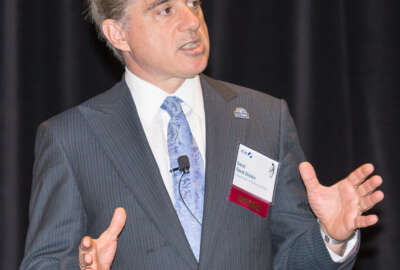

The Veterans Affairs Department is collaborating with OPM and private organizations to solve some of its overarching issues.
The Veterans Affairs Department is addressing systemic internal problems that are lowering employee morale and arresting department progress by collaborating with other agencies and private organizations.
Department employees feel like they are trapped in a structure they can’t change, said Thomas Muir, the director of support services for VA during a Sept. 3 speech in Washington hosted by the American Council for Technology-Industry Advisory Council.
“You can’t have a great veteran experience if your employee morale is terrible. You can’t expect your employees to turn around and put on a smiley face and deliver great services,” said Scott Blackburn, director of the MyVA task force, in charge of changing VA’s internal culture.
VA suffers from the second lowest employee morale in the government, only beating the Department of Homeland Security.
MyVA is meeting with other agencies to solve overarching problems that are a thorn in workers’ sides. Muir said the motifs that are most troublesome are information technology, finance, acquisition and human resources.
VA will work with the Office of Personnel Management to solve some of its hiring issues, considering the VA has 40,000 clinical vacancies, Muir said. When there are that many open spots, employees are under more pressure. Muir didn’t offer any specifics on how VA would work with OPM.
VA also will look outside of the government to fix some of its issues. Muir said the department is meeting with the Cleveland Clinic to work on physician preference and supply chains, which are especially frustrating for VA facility directors and directly impact the service they can provide to veterans.
The department will look internally at best practices to streamline processes that traditionally have hindered VA employees’ ability to meet their missions.
“We’ve got three or four different hiring systems, for example, in the department. Are there best practices in those hiring systems that will reduce the time from a vacancy, particularly one that you anticipate, to the time that you fill it? We know that there are,” Muir said.
Blackburn said VA is implementing metrics with incentives to keep employees on track with the agency’s standards.

Blackburn warned that metrics need to have their own culture around them so they aren’t turned into quotas or tools to blame other employees.
Instead the metrics need to be shared so employees work together. Blackburn offered an example of how to tie metrics across the organization when he was in the private sector working with the field and headquarters unit of a coal company.
“I said ‘Wow you guys work really well together why is that?’ and [the coal field manager] said ‘On my scorecard and their scorecard are the same metrics, so when the train is late in Wyoming we are both sweating it, we are both waking up in the middle of the night calling each other saying how do we fix this,’” Blackburn said.
My VA is trying to put more positive publicity out about the department as well. Blackburn said part of the VA’s morale problem is that the whole department is being dragged down by bad publicity from a few outlying facilities. While a lot of VA facilities function well, the bottom 10 percent receive most of the attention, which makes even good employees feel like they are doing a subpar job.
Copyright © 2025 Federal News Network. All rights reserved. This website is not intended for users located within the European Economic Area.
Scott Maucione is a defense reporter for Federal News Network and reports on human capital, workforce and the Defense Department at-large.
Follow @smaucioneWFED

